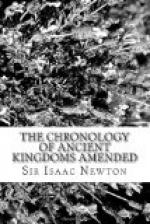In the back of Aries is a Star of the sixth magnitude, marked [nu] by Bayer: in the end of the year 1689, and beginning of the year 1690, its Longitude was [Taurus]. 9 deg.. 38’. 45”, and North Latitude 6 deg.. 7’. 56”: and the Colurus AEquinoctiorum drawn though it, according to Eudoxus, cuts the Ecliptic in [Taurus]. 6 deg.. 58’. 57”. In the head of Cetus are two Stars of the fourth Magnitude, called [nu] and [xi] by Bayer: in the end of the year 1689 their Longitudes were [Taurus]. 4 deg.. 3’. 9”. and [Taurus]. 3 deg.. 7’. 37”, and their South Latitudes 9 deg.. 12’. 26”. and 5 deg.. 53’. 7”; and the Colurus AEquinoctiorum passing in the mid way between them, cuts the Ecliptic in [Taurus]. 6 deg.. 58’. 51”. In the extreme flexure of Eridanus, rightly delineated, is a Star of the fourth Magnitude, of late referred to the breast of Cetus, and called [rho] by Bayer; it is the only Star in Eridanus through which this Colure can pass; its Longitude, in the end of the year 1689, was [Aries]. 25 deg.. 22’. 10”. and South Latitude 25 deg.. 15’. 50”. and the Colurus AEquinoctiorum passing through it, cuts the Ecliptic in [Taurus]. 7 deg.. 12’. 40”. In the head of Perseus, rightly delineated, is a Star of the fourth Magnitude, called [tau] by Bayer; the Longitude of this Star, in the end of the year 1689, was [Taurus]. 23 deg.. 25’. 30”, and North Latitude 34 deg.. 20’. 12”: and the Colurus AEquinoctiorum passing through it, cuts the Ecliptic in [Taurus]. 6 deg.. 18’. 57”. In the right hand of Perseus, rightly delineated, is a Star of the fourth Magnitude, called [eta] by Bayer; its Longitude in the end of the year 1689, was [Taurus]. 24 deg.. 25’. 27”, and North Latitude 37 deg.. 26’. 50”: and the Colurus AEquinoctiorum passing through it cuts the Ecliptic in [Taurus]. 4 deg.. 56’. 40”: and the fifth part of the summ of the




